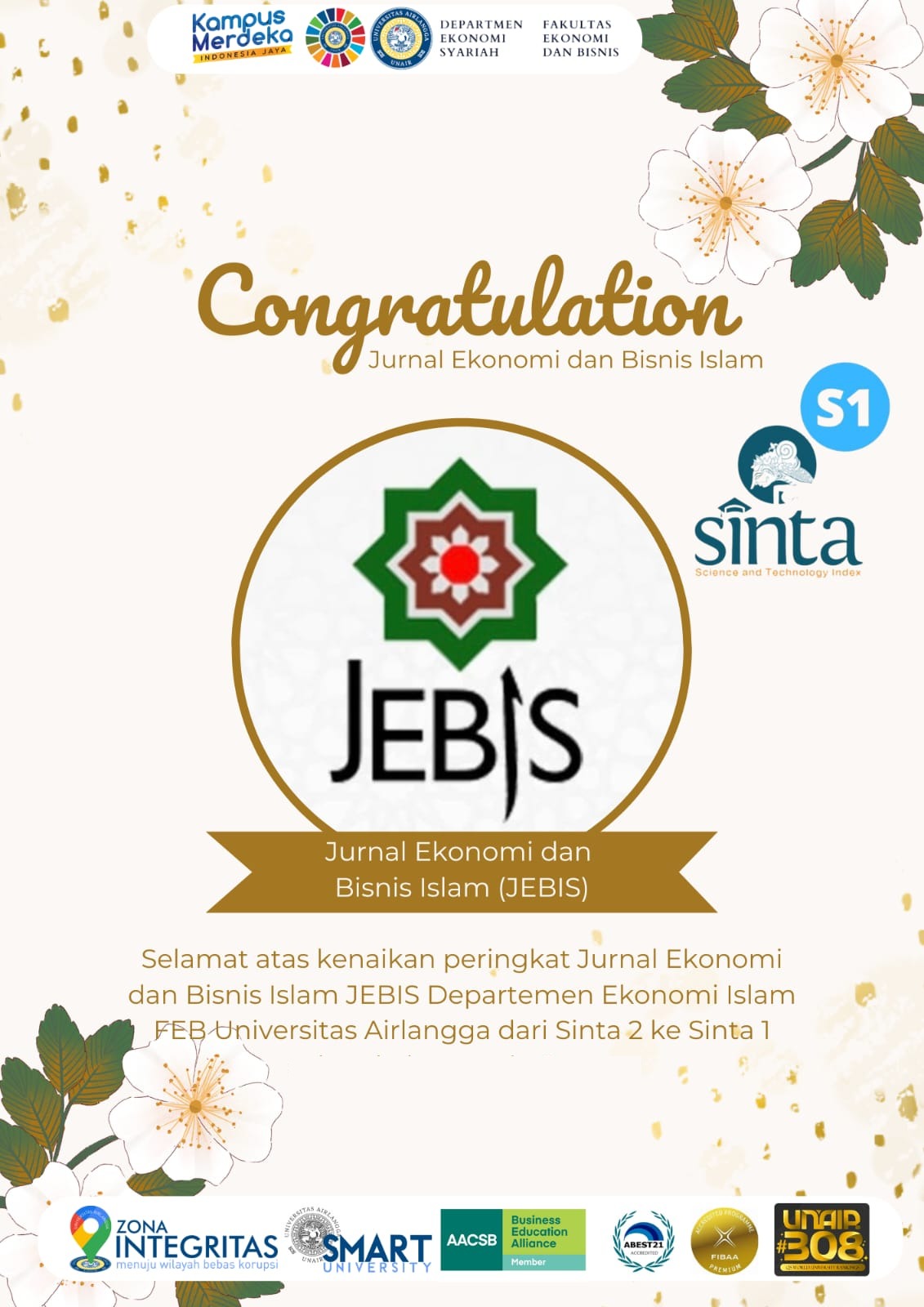EXAMINING THE TREND, THEMES, AND SOCIAL STRUCTURE OF THE ISLAMIC ACCOUNTING USING A BIBLIOMETRIC APPROACH
Downloads
This study focuses on bibliometric indicators of Islamic accounting research development, such as trends in Islamic accounting research and its distribution, topics and themes in Islamic accounting research, significant contributors to Islamic accounting research, the pattern of collaboration in Islamic accounting research, and the most significant texts in the Islamic accounting literature. Four hundred eighty-three pieces of scientific literature were entered into the Scopus database for bibliometric analysis on January 10, 2022. Various programs were used to analyze frequency, metrics, and citations, including Microsoft Excel, VOS viewer, and Harzing's Publish or Perish. Over the last ten years, Islamic accounting publications have grown significantly and steadily. Islamic accounting literature is based in Asia, Europe, America, and the Middle East, and it can be found in social science, business, management, accounting, economics, and finance. With a few exceptions in Malaysian, Arabic, German, Indonesian, Slovak, and Turkish, the majority of Islamic accounting literature is written in English. The study also discovered that terms like Islamic bank, banking, Islamic performance, Islamic accounting standards, and Islamic finance are commonly used. The seven countries that contributed the most to the development of scholarly collaborations in Islamic accounting were Malaysia, Indonesia, the United States, Saudi Arabia, the United Kingdom, Pakistan, and Australia. This is critical in assisting academics in making recommendations for future study in the field of Islamic accounting.
Abdel Karim, R. A. (1995). The Nature and Rationale of a Conceptual Framework for Financial Reporting by Islamic Banks. Accounting and Business Research, 25(100), 285–300. https://doi.org/10.1080/00014788.1995.9729916
Afifuddin, H. B., & Siti-Nabiha, A. K. (2010). Towards good accountability: The role of accounting in Islamic religious organizations. World Academy of Science, Engineering and Technology, 42, 1366–1372.
Ahmi, A., & Mohamad, R. (2020). Bibliometric analysis of global scientific literature on vaccine hesitancy in peer-reviewed journals (1990-2019). BMC Public Health, 20(1). https://doi.org/10.1186/s12889-020-09368-z
Ahmi, A., & Mohd Nasir, M. H. (2019). Examining the trend of the research on extensible business reporting language (xbrl): A bibliometric review. International Journal of Innovation, Creativity and Change, 5(2).
Ambashe, M., & Alrawi, H. A. (2013). The development of accounting through the history. International Journal of Advances in Management and Economics, 2(2), 95–100.
Badshah, I., Mellemvik, F., & Timochenko, K. Y. (2013). Accounting From A Religious Perspective: A Case Of The Central Government Accounting In Islamic Republic Of Pakistan. Asian Economic and Financial Review, 3, 243–258.
Badshah, I., Mellemvik, F., & Timoshenko, K. (2013). ACCOUNTING FROM A RELIGIOUS PERSPECTIVE : A CASE OF THE CENTRAL GOVERNMENT ACCOUNTING IN ISLAMIC REPUBLIC OF Imtiaz Badshah Frode Mellemvik Konstantin Timoshenko. Asian Economic and Financial Review, 3(2), 243–258.
Baydoun, N., & Willett, R. J. (1998). Islam and accounting: Ethical issues in the presentation of financial information. Accounting, Commerce & Finance: The Islamic Perspective, 12(1), 1–25.
Börner, K., Chen, C., & Boyack, K. W. (2003). Visualizing knowledge domains. Annual Review of Information Science and Technology, 37(1), 179–255.
El-Halaby, S., Aboul-Dahab, S., & Bin Qoud, N. (2020). A systematic literature review on AAOIFI standards. Journal of Financial Reporting and Accounting, 19(2), 133–183. https://doi.org/10.1108/JFRA-06-2020-0170
El Qorchi, M. (2005). Islamic finance gears up. Finance and Development, 42(4), 46–49.
Faizah, N. I., Puspita, F. F., & Lestari, D. (2021). Growth Rates Of Islamic Finance: A Bibliometric Analysis Based On The Number Of Publications. Jurnal Imara, 5(2), 101–112.
Gambling, T. E., & Karim, R. A. A. (1986). Islam and ‘social accounting.' Journal of Business Finance & Accounting, 13(1), 39–50.
Hamid, S., Craig, R., & Clarke, F. (1993). Religion: A Confounding Cultural Element in the International Harmonization of Accounting? Abacus, 29(2), 131–148. https://doi.org/10.1111/j.1467-6281.1993.tb00427.x
Handoko, L. H., & Mardian, S. (2021). Mapping the Knowledge of Islamic Accounting Studies on Shariah Audit: A Bibliometric Analysis. Library Philosophy and Practice, 102, 1–16.
Haniffa, R., & Hudaib, M. (2014). The Islamic accounting triangle: Measurement, disclosure and enforcement. In Handbook on Islam and Economic Life (pp. 227–242). Edward Elgar Publishing Ltd. https://doi.org/10.4337/9781783479825.00020
Haniffa, Roszaini. (2008). Haniffa, R., Hudaib, M. & Mirza, M. (2008), Accounting Policy Choice Within the Shari'ah Islami'iah Framework, in Bakar, M. D. and Engku Ali, E. R. A. (eds.), Essential Readings in Islamic Finance, Malaysia, CERT, p: 317-344.
Haniffa, Roszaini, & Hudaib, M. (2010). The two Ws of Islamic accounting research. Journal of Islamic Accounting and Business Research, 1(1), 5–9. https://doi.org/10.1108/17590811011033370
Hassan, A., & Syafri Harahap, S. (2010). Exploring corporate social responsibility disclosure: the case of Islamic banks. International Journal of Islamic and Middle Eastern Finance and Management, 3(3), 203–227. https://doi.org/10.1108/17538391011072417
Hassan, M. K., Alshater, M. M., Mumu, J. R., Sarea, A. M., & Azad, M. A. K. (2021). Bibliometric analysis of the Journal of Islamic Accounting and Business Research : Ten years review. COLLNET Journal of Scientometrics and Information Management, 15(1), 63–88. https://doi.org/10.1080/09737766.2021.1934603
Hayashi, T. (1989). Islamic Accounting: Its Future Impact on Western Accounting On. Institute of Middle Eastern Studies, International University of Japan.
Htay, S. N. N., & Salman, S. A. (2013). Balanced score card approach for better Shari'Ah corporate governance. American Journal of Applied Sciences, 10(12), 1553–1557. https://doi.org/10.3844/ajassp.2013.1553.1557
Kamla, R. (2009). Critical insights into contemporary Islamic accounting. Critical Perspectives on Accounting, 20(8), 921–932. https://doi.org/10.1016/j.cpa.2009.01.002
Kamla, R., Gallhofer, S., & Haslam, J. (2006). Islam, nature and accounting: Islamic principles and the notion of accounting for the environment. Accounting Forum, 30(3), 245–265. https://doi.org/10.1016/j.accfor.2006.05.003
Kamla, R., & Rammal, H. G. (2013). Social reporting by Islamic banks: Does social justice matter? Accounting, Auditing and Accountability Journal, 26(6), 911–945. https://doi.org/10.1108/AAAJ-03-2013-1268
Karim, R. A. A. (1990). Standard Setting for the Financial Reporting of Religious Business Organizations: The Case of Islamic Banks. Accounting and Business Research, 20(80), 299–305. https://doi.org/10.1080/00014788.1990.9728888
Karim, R. A. A. (2001). International accounting harmonization, banking regulation, and Islamic banks. International Journal of Accounting, 36(2), 169–193.
Lutz, W. (1984). Factors behind global fertility development after 1950: a multivariate analysis of 128 countries . Demographische Informationen / hrsg. vom Institut fur Demographie, Osterreichische Akademie der Wissenschaften, 21-48,175.
Maali, B., Casson, P., & Napier, C. (2006). Social reporting by islamic banks. Abacus, 42(2), 266–289. https://doi.org/10.1111/j.1467-6281.2006.00200.x
Mallin, C., Farag, H., & Ow-Yong, K. (2014). Corporate social responsibility and financial performance in Islamic banks. Journal of Economic Behavior and Organization, 103, S21–S38. https://doi.org/10.1016/j.jebo.2014.03.001
Martí-Parreño, J., Méndez Ibáñez, E., & Alonso Arroyo, A. (2016). The use of gamiï¬cation in education: A bibliometric and text mining analysis. Journal of Computer Asissted Learning, 32(6), 663–676.
Martín-Martín, A., Orduna-Malea, E., Thelwall, M., & Delgado López-Cózar, E. (2018). Google Scholar, Web of Science, and Scopus: A systematic comparison of citations in 252 subject categories. Journal of Informetrics, 12(4), 1160–1177. https://doi.org/10.1016/j.joi.2018.09.002
Mirza, M., & Baydoun, N. (1999). Do Islamic societies need their own accounting and reporting standards? Journal of the Academy of Business Administration, 4(2), 39–45.
Napier, C. (2009). Defining Islamic accounting: Current issues, past roots. Accounting History, 14(1–2), 121–144. https://doi.org/10.1177/1032373208098555
Naser, K., & Nuseibeh, R. (2003). Quality of financial reporting: evidence from the listed Saudi nonfinancial companies. The International Journal of Accounting, 38(1), 41–69.
Olson, D., & Zoubi, T. A. (2008). Using accounting ratios to distinguish between Islamic and conventional banks in the GCC region. International Journal of Accounting, 43(1), 45–65. https://doi.org/10.1016/j.intacc.2008.01.003
Pomeranz, F. (1997). The Accounting and Auditing Organization for Islamic Financial Institutions: An important regulatory debut. Journal of International Accounting, Auditing and Taxation, 6(1), 123–130. https://doi.org/10.1016/S1061-9518(97)90016-1
Rahman, A. A., & Bukair, A. A. (2013). The influence of the Shariah supervision board on corporate social responsibility disclosure by Islamic banks of Gulf Co-operation Council countries. Asian Journal of Business and Accounting, 6(2), 65–105.
Rahman, S. (2000). Islamic accounting standards. Retrieved June, 21, 2005.
Ramachandran, N., & Kakani, R. K. (2020). Financial Accounting For Management|. McGraw-Hill Education.
Raman, A. A., & Bukair, A. A. (2013). The influence of the Shariah supervision board on corporate social responsibility disclosure by Islamic banks of Gulf Co-operation Council countries. Asian Journal of Business and Accounting, 6(2).
Restuningdiah, N., Wafaretta, V., & Furqorina, R. (2020). A Mapping of Islamization of Accounting. KnE Social Sciences, 2020, 420–436. https://doi.org/10.18502/kss.v4i9.7341
Rusydiana, A., Taqi, M., Firmansyah, I., Assalafiyah, A., & Kustiningsih, N. (2021). A Bibliometric Analysis of Islamic Accounting Research Indexed by DigitalCommons @ University of Nebraska - Lincoln A Bibliometric Analysis of Islamic Accounting Research Indexed by Dimensions . ai. Library Philosophy and Practice, January.
Saidat, Z. M. F. Al, AL-Ghazzawi, A. M., & Sulihat, N. A. (2014). Accounting Measurements : Islamic Perspective versus Financial Accounting Perspective. Interdisciplinary Journal of Contemporary Research in Business, 6(2), 362–377.
Suhaimi Nahar, H., & Yaacob, H. (2011). Accountability in the sacred context: The case of management, accounting and reporting of a Malaysian cash awqaf institution. Journal of Islamic Accounting and Business Research, 2(2), 87–113. https://doi.org/10.1108/17590811111170520
Sweileh, W. M., Al-Jabi, S. W., AbuTaha, A. S., Zyoud, S. H., Anayah, F. M. A., & Sawalha, A. F. (2017). Bibliometric analysis of worldwide scientific literature in mobile - health: 2006-2016. BMC Medical Informatics and Decision Making, 17(1), 1–12. https://doi.org/10.1186/s12911-017-0476-7
Trokic, A. (2015). Islamic Accounting; History, Development and Prospects. European Journal of Islamic Finance, 0(3), 1–6. https://doi.org/10.13135/2421-2172/1043
Valérie, D., & Pierre, A. G. (2010). Bibliometric idicators: Quality masurements of sientific publication. Radiology, 255(2), 342–351. https://doi.org/10.1148/radiol.09090626
Van Eck, Nees Jan, & Waltman, L. (2014). Visualizing bibliometric networks. In Measuring scholarly impact (pp. 285–320). Springer.
Van Eck, Ness Jan, & Waltman, L. (2017). VOSviewer manual. Manual for VOSviewer. Leiden University.
Velayutham, S. (2014). "Conventional” accounting vs "Islamic” accounting: the debate revisited. Journal of Islamic Accounting and Business Research, 5(2), 126–141. https://doi.org/10.1108/JIABR-05-2012-0026
Zaid, O. A. (2004). Accounting systems and recording procedures in the early Islamic state. Accounting Historians Journal, 31(2), 149–170. https://doi.org/10.2308/0148-4184.31.2.149
Zaleha Abdul Rasid, S., Rahim Abdul Rahman, A., & Khairuzzaman Wan Ismail, W. (2011). Management accounting systems in Islamic and conventional financial institutions in Malaysia. Journal of Islamic Accounting and Business Research, 2(2), 153–176. https://doi.org/10.1108/17590811111170557
Copyright (c) 2022 JEBIS (Jurnal Ekonomi dan Bisnis Islam) | JOURNAL OF ISLAMIC ECONOMICS AND BUSINESS

This work is licensed under a Creative Commons Attribution-NonCommercial-ShareAlike 4.0 International License.
- Every manuscript submitted to JEBIS must obey to the policy and terms set by Journal of Economics and Business Islamic.
- Publication rights on the contents of manuscript published by JEBIS is owned by JEBIS under consent and approval by the corresponding author(s).
- Full text of electronic publication of manuscripts can be accessed free if used for the purpose of education and research according to copyright regulation.
- Share ” copy and redistribute the material in any medium or format
- Adapt ” remix, transform, and build upon the material
- You must give appropriate credit, provide a link to the license, and indicate if changes were made. You may do so in any reasonable manner, but not in any way that suggests the licensor endorses you or your use.
- You may not use the material for commercial purposes.
- If you remix, transform, or build upon the material, you must distribute your contributions under the same license as the original.
Creative Commons Attribution-NonCommercial-ShareAlike 4.0 International License.





.png)














